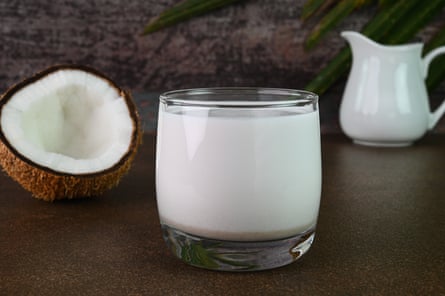The dairy aisle might need a new name, given the diversity of products on offer. Dana Ellis Hunnes, a senior clinical dietitian at UCLA Health, says her local grocery store often stocks more non-dairy milk options than dairy ones. She’s tried various options, including a brief phase with coconut milk (“It was too creamy and too watery at the same time”). Now, she enjoys oat milk, which adds the right amount of creaminess to her coffee.
The best choice depends on individual needs and preferences, says Hunnes. One person might want to add more protein to their diet, while another might be looking to increase their calcium intake. Flavor and mouthfeel are also important considerations.
While dairy milk remains the most popular option in the United States and the United Kingdom, alternatives are here to stay. Here’s what experts say about how to select the right one for your lifestyle.
How to pick your alternative milk
Adults who use alternative milks do so for various reasons, including pursuing a plant-based diet, reducing their carbon footprint or managing lactose intolerance.
“The question of ‘what’s healthy or not?’ is a personal one,” says Abigail Johnson, an assistant professor and associate director of the Nutrition Coordinating Center at the University of Minnesota School of Public Health. “You need to think about what nutrients you need and consider the milk that can best add those to your diet.”
Johnson is the lead author of a 2025 study that assessed the nutrient content of plant-based milks available in the United States. The study, which examined 219 plant-based milk alternatives from 21 brands, found that these alternatives were generally lower in protein and saturated fatty acids than dairy milk. Nutrients are often added to help alternative milks compete with dairy milk; 70% of the products were fortified with calcium and vitamin D, and other research shows alternative milks are sometimes also fortified with vitamins A and B12.

Adults likely don’t need to choose an alternative milk that matches dairy milk’s nutrient profile exactly, because they get those nutrients from other parts of their diet – unless they are especially concerned about their calcium intake, explains Dr Joan Sabate, a professor and executive director of the Center for Nutrition, Lifestyle and Disease Prevention at Loma Linda University.
Checking the label is important when determining which product is right for you. The study found that the nutrient content of alternative milks varied. For instance, soy milk brands can contain different amounts of protein. “You can’t just pick a plant-based milk off the shelf and assume it’s going to meet your calcium needs,” says Johnson.
Hunnes does “strongly recommend that people try to go for the unsweetened varieties” to minimize their sugar intake.
“If someone is trying to get more protein, but with as minimal amount of sugar as possible, I might suggest they go for unsweetened pea protein milk or unsweetened soy milk,” she says.
For most people, alternative milks will only make up a small part of their overall diet, says Hunnes. With that in mind, these milks “won’t make or break someone’s healthfulness”, says Hunnes. “People should focus on what kind they like best.”
Do alternative milks contain seed oils?
Because many alternative milks lack fat, manufacturers may add seed oil to give the liquids a smooth taste and consistency. Seed oils may also be used as emulsifiers to prevent ingredient separation.
Experts say research does not support claims that seed oils are toxic or drive chronic disease. But claims like Maha figurehead Robert F Kennedy Jr’s – that Americans are “unknowingly poisoned” by these products – have led some consumers to avoid them.
Some seed oils can be pro-inflammatory if consumed in very high amounts, explains Hunnes, but the amount of seed oil in some alternative milks isn’t enough to warrant concern, since people are likely to consume only half to a full cup daily.
“Unless people are drinking a half a gallon of these non-dairy milks a day, it’s not something I would be concerned about,” says Hunnes.
Research also suggests plant-derived oils may mitigate cardiovascular disease risk factors, says Johnson. “There’s not necessarily anything wrong with wanting to avoid seed oils and emulsifiers, but some perceived risks might not be accurate,” she says.
Studies generally show that these oils are associated with lower mortality than butter, and experts have observed that the purported adverse effects of seed oils have been conflated with the unhealthy foods they are sometimes used in.
What are the pros and cons of each alternative milk?
Soy milk: Johnson’s study found that soy-based products were most nutritionally similar to dairy milk. This is why Sabate recommends soy milk over other alternatives for children. It is also so similar to dairy milk in that it is the only alternative included in the dairy section of the US dietary guidelines for Americans.
Soy also has various beneficial, naturally occurring chemical compounds, says Sabate. These can support heart, kidney and liver health, she says. These include isoflavones, which are structurally similar to estrogen. This similarity may be why soy milk is linked to a lower risk of breast cancer and reduced hot flashes (although the evidence is mixed).
This similarity has led to a false assumption that drinking soy milk could have feminizing effects on men, despite study after study showing that’s not true. For example, a review of 38 clinical studies found no adverse effects of soy on men. In one extremely rare case, in which a man’s breasts grew after drinking soy milk, he was consuming 1.2 liters of daily for three years.
after newsletter promotion
Oat milk: Oat milk can be a good option for those who want a really creamy substitute, says Hunnes. According to a 2022 UC Davis report, it is the most popular alternative after almond milk, and demand is growing. This may be because oat milk’s sensory qualities are similar to dairy milk; oat milk also often contains more sugar than almond, soy, pea and coconut milks.
It also contains phytates, compounds with antioxidant properties that can help prevent bone loss and kidney stone formation. Some research suggests that oat milk may be an appropriate dairy substitute for individuals with irritable bowel syndrome or inflammatory bowel disease due to its anti-inflammatory properties. Oat milk also has more fiber than many alternative milks, except for rice milk.
Phytates can impair the absorption of iron, zinc and calcium; however, consuming oat milk along with a balanced, nutrient-rich diet should minimize any adverse effects.
Almond milk: Those looking for something low-calorie or who are concerned about their blood sugar might want to try unsweetened almond milk, says Hunnes. It might also appeal to consumers who prioritize foods with fewer ingredients; there’s rising interest in simpler ingredient lists, so consumers can better understand the health impacts of a product.
That said, 2023 research found that almond milk has less protein than cashew, hemp, pea and soy milk. It has more protein than coconut and rice milk.
Production of almond milk also involves more water use than other plant-based milks – though dairy production still uses significantly more water.
Coconut milk: Coconut milk has high levels of saturated fat, and is thus often marketed as having a mouthfeel similar to whole milk, explains Johnson.

Critically, the American Heart Association advises limiting saturated fats to less than 6 % of your total calories, so experts recommend moderation.
More research on coconut milk is needed to understand its health effects. But there is some evidence that it contains antioxidative compounds that protect against DNA oxidative damage, which is linked to ageing-related diseases.
Rice milk: Rice milk is made from milled rice and water, and is often fortified with calcium and vitamin D. Because it is very low in protein – one serving may contain 0.9 grams of protein, compared with 2.4 grams in oat milk and 1.7 grams in almond milk – experts recommend combining it with other protein-rich foods.
Rice milk may appeal to some because it’s low in saturated fat and cholesterol, and it’s the least allergenic of milk alternatives. It’s sometimes the choice of athletes and others with high energy needs because it contains more carbohydrates.
All rice can potentially contain arsenic because rice plants absorb the element from the soil. There are no dietary limits for arsenic in rice milk, but some reports advise caution around intake for children. Because young children eat three times more food for their size than adults do, they are more likely to take in higher amounts of inorganic arsenic from their diet. For instance, the FDA recommends that infant rice cereals not contain more than 100 parts per billion of inorganic arsenic.
There’s a need for more research to know the health effects of consuming arsenic via rice milk, though exposure is likely very low unless you’re drinking a lot of rice milk. People consume an estimated 5 to 25 micrograms of arsenic daily as part of their diet.
Blended milk: Blended milks are relatively new and need further study. One 2024 paper suggests blended milks have a more similar mouthfeel to dairy milk than non-blended alternatives.
Some alternative milk products combine various plant protein sources, and may be fortified with calcium, vitamin D and other nutrients.
If you want a product with a higher protein content, opt for soy or pea, which naturally contain protein, or blended products with those ingredients, says Johnson. Pea milk, for example, may have 7 grams more protein per one-cup serving than almond milk, and also naturally contains vitamin A. Research suggests that blending different plant proteins can create a more nutritious product.

 3 hours ago
8
3 hours ago
8

















































